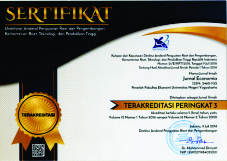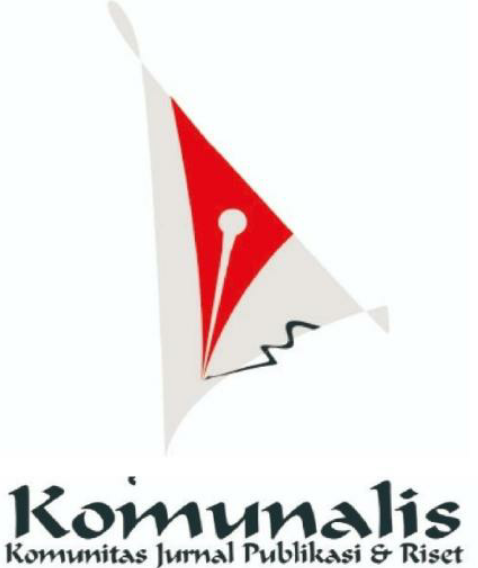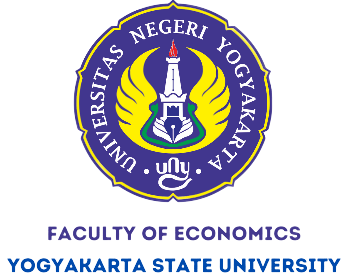Financial Availability on Performance of MSMEs: Mediation of Entrepreneurial Orientation and Business Actor's Rationality
Downloads
This study investigates how business actors' entrepreneurial orientation and rationality affect MSMEs' performance, as well as how the availability of financing affects that performance. Using a random sampling technique, we surveyed 195 MSMEs from various business fields. The data were analyzed using structural equation modeling and AMOS and SPSS software. We discovered that the mediation of entrepreneurial orientation and decision-making rationality significantly impacted the relationship between financial availability and performance. Adequate funding encourages an entrepreneurial mindset and the development of innovations that improve overall performance. The study suggests that business actors improve their capabilities, including managerial skills, practices, and procedures in the financial sector. When adequate funds are available, they could be used to improve performance. The study adds to the dynamic capability theory by demonstrating that MSMEs must be able to integrate, construct, and reconfigure their financial resources in the face of rapid environmental changes.
Downloads
Aminu, I. M., & Shariff, M. N. M. (2015). Influence of strategic orientation on SMEs access to finance in Nigeria. Asian Social Science, 11(4), 298–309. https://doi.org/10.5539/ass.v11n4p298
Anwar, M., & Li, S. (2021). Spurring competitiveness, financial and environmental performance of SMEs through government financial and non-financial support. Environment, Development and Sustainability, 23(5), 7860–7882. https://doi.org/10.1007/s10668-020-00951-3
Anwar, M. (2018). Business model innovation and SMEs performance-Does competitive advantage mediate? International Journal of Innovation Management, 22(7), 1–31. https://doi.org/10.1142/S1363919618500573
Anwar, M., Shuangjie, L., & Ullah, R. (2020). Business experience or Financial Literacy? Which one is better for opportunity recognition and superior performance? Business Strategy and Development, 3(3), 377–387. https://doi.org/10.1002/bsd2.103
Asia Pacific Foundation of Canada lobal Partnership for Financial Inclusion. (2018). G Survey of Entrepreneurs and SMEs In Indonesia.
Barney, J. (1991). Firm Resources and Sustained Competitive Advantage. Journal of Management, Vol. 17, pp. 99–120. https://doi.org/10.1177/014920639101700108
Barney, J.B., & Hesterly, W.S. (2015). Strategic Management and Competitive Advantage: Concepts and Cases: Boston: Pearsonheelen.
Baron, R. A. (2006). Opportunity recognition as pattern recognition: How entrepreneurs "connect the dots" to identify new business opportunities. Academy of Management Perspectives, 20(1), 104–119. https://doi.org/10.5465/AMP.2006.19873412
Clement, K., & Hansen, M. (2003). Financial incentives to improve environmental performance: A review of nordic public sector support for SMEs. European Environment, 13(1), 34–47. https://doi.org/10.1002/eet.308
Cui, L., Fan, D., Guo, F., & Fan, Y. (2018). Explicating the relationship of entrepreneurial orientation and firm performance: Underlying mechanisms in the context of an emerging market. Industrial Marketing Management, 71(November), 27–40. https://doi.org/10.1016/j.indmarman.2017.11.003
Egena, O., Wombo, D. N., Theresa, E. E., & Bridget, M. N. (2014). Institutional Support for Small and Medium Enterprises in Nigeria : An Empirical Investigation. International Journal of Economy, Management and Social Sciences, 3(9), 481–489.
Eniola, A. A., & Entebang, H. (2017). SME Managers and Financial Literacy. Global Business Review, 18(3), 559–576. https://doi.org/10.1177/0972150917692063
Fowowe, B. (2017). Access to finance and firm performance: Evidence from African countries. Review of Development Finance, 7(1), 6–17. https://doi.org/10.1016/j.rdf.2017.01.006
García-Pérez-de-Lema, D., Ruiz-Palomo, D., & Diéguez-Soto, J. (2021). Analysing the roles of CEO's financial literacy and financial constraints on Spanish SMEs technological innovation. Technology in Society, 64(July 2020). https://doi.org/10.1016/j.techsoc.2020.101519
Guo, R. (2019). Effectuation, opportunity shaping and innovation strategy in high-tech new ventures. Management Decision, 57(1), 115–130. https://doi.org/10.1108/MD-08-2017-0799
Hossain, M., Yoshino, N., & Taghizadeh-Hesary, F. (2021). Optimal branching strategy, local financial development, and SMEs' performance. Economic Modelling, 96(March), 421–432. https://doi.org/10.1016/j.econmod.2020.03.027
KaradaÄŸ, H. (2018). Cash, receivables and inventory management practices in small enterprises: their associations with financial performance and competitiveness. Small Enterprise Research, 25(1), 69–89. https://doi.org/10.1080/13215906.2018.1428912
Kardkarnklai, W., Thapayom, A., & Pornpundejwittaya, P. (2021). Guidelines for Promoting Sme Entrepreneurs' Access To Financial Services in the Digital Economy. Academy of Strategic Management Journal, 20(Special Issue 3), 1–10.
Kementerian Perdagangan. (2018). Analisis Peran Lembaga Pembiayaan dalam Pengembangan UMKM. Jakarta: Kementerian Perdagangan.
Khan, R. U., Salamzadeh, Y., Kawamorita, H., & Rethi, G. (2021). Entrepreneurial Orientation and Small and Medium-sized Enterprises' Performance; Does "˜Access to Finance' Moderate the Relation in Emerging Economies? Vision, 25(1), 88–102. https://doi.org/10.1177/0972262920954604
Kim, H. S., & Cho, K. S. (2020). Financing resources of SMEs and firm performance: Evidence from Korea. Asian Journal of Business and Accounting, 13(2), 1–26. https://doi.org/10.22452/ajba.vol13no2.1
Kotze, L., & Smit, A. v. A. (2008). Personal Finances: What is the Possible Impact on Entrepreneurial Activity in South Africa? Southern African Business Review, 12(3), 156–172. Retrieved from http://reference.sabinet.co.za.ezproxy.uct.ac.za/webx/access/electronic_journals/sabr/sabr_v12_n3_a7.pdf
Lee, J., Lee, C., Kim, J., Kim, S., & Im, H. (2019). An empirical study on the effect of innovation financing on technology innovation competency: business performance of SMEs in Korea. Journal of Electronic Commerce in Organizations, 17(1), 1–15. https://doi.org/10.4018/JECO.2019010101
Lumpkin, G T., and Dess, G. G. (1996). Clarifying the Entrepreneurial Orientation Construct and Linking it to Performance. Academy of Management Review, 21(1), 135-172.
Lusardi, A., Mitchell, O. S., & Curto, V. (2010). The Journal of Consumer Affairs. The Journal of Consumer Affairs, 44(2), 358–380. Retrieved from http://www.councilforeconed.org/wp/wp-content/uploads/2011/11/Financial-Literacy-for-Young-Lusardi.pdf
Maesaroh, S. S. (2020). Upaya Peningkatan Daya Saing Usaha Mikro, Kecil, dan Menengah (UMKM) Kota Tasikmalaya melalui Pemanfaatan System Informasi Geografis (SIG). Jurnal Ilmu Manajemen Dan Bisnis, 11(1), 61–74. https://doi.org/10.17509/jimb.v11i1.21148
Maesaroh, S. S. (2022). Analisis Faktor Konfirmatori dalam Mengukur Kapasitas Target Pendahuluan Salah satu fungsi utama perbankan yaitu sebagai penyalur dana kredit kepada. WAHANA: Jurnal Ekonomi, Manajemen Dan Akuntansi, 25(1), 12–29.
Mahmud & Huda. (2011). SMEs' Access to Finance: An Indonesia Case Study. SMEs' Accessto Finance: An Indonesia Case. Jakarta: IGI Global.
Memon, A., Yong An, Z., & Memon, M. Q. (2020). Does financial availability sustain financial, innovative, and environmental performance? Relation via opportunity recognition. Corporate Social Responsibility and Environmental Management, 27(2), 562–575. https://doi.org/10.1002/csr.1820
Moscalu, M., Girardone, C., & Calabrese, R. (2020). SMEs' growth under financing constraints and banking markets integration in the euro area. Journal of Small Business Management, 58(4), 707–746. https://doi.org/10.1080/00472778.2019.1668722
Mostafa A. Ali, Nazimah Hussin, Hossam Haddad, Dina Alkhodary and Ahmad Marei. (2021). Dynamic Capabilities and Their Impact on Intellectual Capital and Innovation Performance. Sustainability 2021, 13, 10028 : pp, 1-32.. https://doi.org/10.3390/su131810028.
Nugroho. (2020). Survey Kinerja UMKM di Masa Pandemi Covid-19. 22 Juli 2021, from http://lipi.go.id/berita/survei-kinerja-umkm-di-masa-pandemi-covid19/22071.
Omerzel, D.G., & Gulev, R.E. (2011). Knowledge Resources and Competitive Advantage. Managing global transitions, 9, 335-354.
Owusu, J., Owusu Ansah, W., Djan, K. O., & Anin, E. K. (2021). Impact of financial resource building effort on financial resource availability among small and medium enterprises. Cogent Business and Management, 8(1). https://doi.org/10.1080/23311975.2021.1920676
Popa, S., Soto-Acosta, P., & Perez-Gonzalez, D. (2018). An investigation of the effect of electronic business on financial performance of Spanish manufacturing SMEs. Technological Forecasting and Social Change, 136, 355–362. https://doi.org/10.1016/j.techfore.2016.08.012
Rohra,C.I., & Panhwar, I.A. (2009). The role of SMEs towards exports in Pakistan economy. Australian Journal of Basic and Applied Sciences, 3 (2),1070-1082.
Shane, S., & Venkataraman, S. (2012). Note as the promise of entrepreneurship. The Academy of Management Review, 25(1), pp.217-226.
Shirokova, G., Bogatyreva, K., Beliaeva, T., & Puffer, S. (2016). Entrepreneurial orientation and firm performance in different environmental settings. Journal of Small Business and Enterprise Development, 23(3), 703–727. https://doi.org/10.1108/jsbed-09-2015-0132
[SMEDA] Small and Medium-sized Enterprises Development Authority. (2016). SMEDA Report. Retrieved, 1 November 2018, from http://www.smeda.org.
Tambunan, T. (2020). MSMEs in times of crisis. evidence from Indonesia. Journal of Developing Economies, 5(2), 89-102. doi: https://doi.org/10.20473/jde.v5i2.20848.
Teece, D. J., Pisano, G., & Shuen, A. (1997). Dynamic capabilities and strategic management. Strategic Management Journal, 18(7), 509–533.
Wardati, N. K., & Er, M. (2019). The impact of social media usage on the sales process in small and medium enterprises (SMEs): A systematic literature review. Procedia Computer Science, 161, 976–983. https://doi.org/10.1016/j.procs.2019.11.207
Ying, Q., Hassan, H., & Ahmad, H. (2019). The role of a manager's intangible capabilities in resource acquisition and sustainable competitive performance. Sustainability (Switzerland), 11(2). https://doi.org/10.3390/su11020527
Yavarzadeh, R., Salamzadeh, A., & Dashtbozorg, A. (2015). Measurement of organizational maturity in knowledge management implementation. International journal of Economic, commerce and management, 3(10), 318-344.















